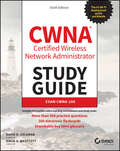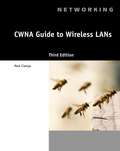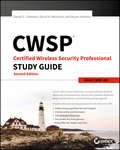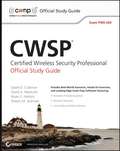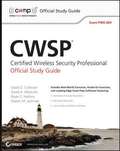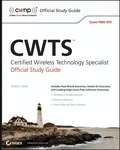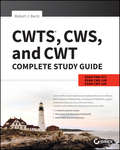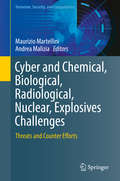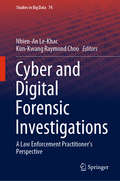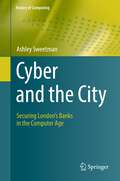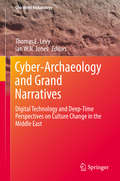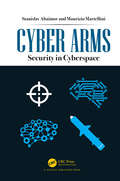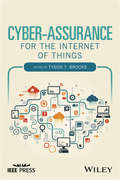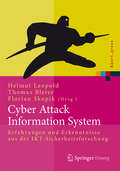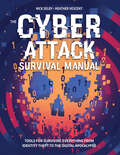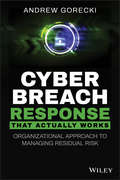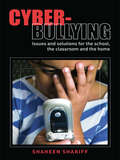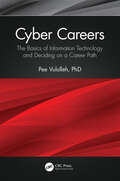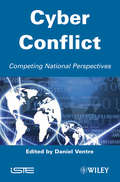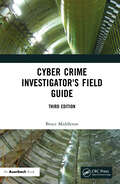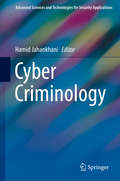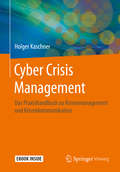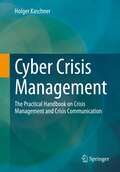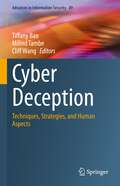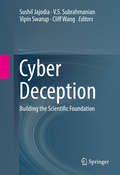- Table View
- List View
CWNA Certified Wireless Network Administrator Study Guide: Exam CWNA-108
by David A. Westcott David D. ColemanThe #1 selling Wi-Fi networking reference guide in the world The CWNA: Certified Wireless Network Administrator Study Guide is the ultimate preparation resource for the CWNA exam. Fully updated to align with the latest version of the exam, this book features expert coverage of all exam objectives to help you pass the exam. But passing the exam is just a first step. For over 16 years, the CWNA Study Guide has helped individuals jump-start their wireless networking careers. Wireless networking professionals across the globe use this book as their workplace reference guide for enterprise Wi-Fi technology. Owning this book provides you with a foundation of knowledge for important Wi-Fi networking topics, including: Radio frequency (RF) fundamentals 802.11 MAC and medium access Wireless LAN topologies and architecture WLAN design, troubleshooting and validation Wi-Fi networking security The book authors have over 40 years of combined Wi-Fi networking expertise and provide real-world insights that you can leverage in your wireless networking career. Each of the book’s 20 chapters breaks down complex topics into easy to understand nuggets of useful information. Each chapter has review questions that help you gauge your progress along the way. Additionally, hands-on exercises allow you to practice applying CWNA concepts to real-world scenarios. You also get a year of free access to the Sybex online interactive learning environment, which features additional resources and study aids, including bonus practice exam questions. The CWNA certification is a de facto standard for anyone working with wireless technology. It shows employers that you have demonstrated competence in critical areas, and have the knowledge and skills to perform essential duties that keep their wireless networks functioning and safe. The CWNA: Certified Wireless Network Administrator Study Guide gives you everything you need to pass the exam with flying colors.
CWNA Guide To Wireless LANs
by Mark CiampaCWNA GUIDE TO WIRELESS LANS, 3rd Edition provides you with the conceptual knowledge and hands-on skills needed to work with wireless technology in a network administration environment as well as pass the Certified Wireless Network Administrator (CWNA) exam. The text covers fundamental topics, such as planning, designing, installing, securing, and configuring wireless LANs. It also details common wireless LAN uses including maintenance, security, and business applications. The third edition is designed around the latest version of the CWNA exam, as well as the new IEEE 802. 11 standard, making CWNA GUIDE TO WIRELESS LANS the practical guide that prepares you for real-world wireless networking.
CWSP: Exam CWSP-205
by Bryan E. Harkins David D. Coleman David A. WestcottThe most detailed, comprehensive coverage of CWSP-205 exam objectives CWSP: Certified Wireless Security Professional Study Guide offers comprehensive preparation for the CWSP-205 exam. Fully updated to align with the new 2015 exam, this guide covers all exam objectives and gives you access to the Sybex interactive online learning system so you can go into the test fully confident in your skills. Coverage includes WLAN discovery, intrusion and attack, 802.11 protocol analysis, wireless intrusion prevention system implementation, Layer 2 and 3 VPN over 802.11 networks, managed endpoint security systems, and more. Content new to this edition features discussions about BYOD and guest access, as well as detailed and insightful guidance on troubleshooting. With more than double the coverage of the "official" exam guide, plus access to interactive learning tools, this book is your ultimate solution for CWSP-205 exam prep. The CWSP is the leading vendor-neutral security certification administered for IT professionals, developed for those working with and securing wireless networks. As an advanced certification, the CWSP requires rigorous preparation -- and this book provides more coverage and expert insight than any other source. Learn the ins and outs of advanced network security Study 100 percent of CWSP-205 objectives Test your understanding with two complete practice exams Gauge your level of preparedness with a pre-test assessment The CWSP is a springboard for more advanced certifications, and the premier qualification employers look for in the field. If you've already earned the CWTS and the CWNA, it's time to take your career to the next level. CWSP: Certified Wireless Security Professional Study Guide is your ideal companion for effective, efficient CWSP-205 preparation.
CWSP: Certified Wireless Security Professional
by David A. Westcott David D. Coleman Bryan E. Harkins Shawn M. JackmanSybex is now the official publisher for Certified Wireless Network Professional, the certifying vendor for the CWSP program. This guide covers all exam objectives, including WLAN discovery techniques, intrusion and attack techniques, 802. 11 protocol analysis. Wireless intrusion-prevention systems implementation, layer 2 and 3 VPNs used over 802. 11 networks, and managed endpoint security systems. It also covers enterprise/SMB/SOHO/Public-Network Security design models and security solution implementation, building robust security networks, wireless LAN management systems, and much more.
CWSP Certified Wireless Security Professional Official Study Guide
by David A. Westcott Shawn M. Jackman Bryan E. Harkins David D. ColemanSybex is now the official publisher for Certified Wireless Network Professional, the certifying vendor for the CWSP program. This guide covers all exam objectives, including WLAN discovery techniques, intrusion and attack techniques, 802.11 protocol analysis. Wireless intrusion-prevention systems implementation, layer 2 and 3 VPNs used over 802.11 networks, and managed endpoint security systems. It also covers enterprise/SMB/SOHO/Public-Network Security design models and security solution implementation, building robust security networks, wireless LAN management systems, and much more.
CWTS: Certified Wireless Technology Specialist Official Study Guide
by Bartz Robert J.About the Book This Official Study Guide for the CWTS exam features complete coverage of the exam objectives, as well as hands-on exercises, Real World Scenarios, chapter review questions, a detailed glossary, objective map, and a pre-assessment test. The enhanced CD includes two bonus exams, 150 flashcards, Case Studies, and demo software. Exam coverage includes: Wi-Fi Technology, Standards, and Certifications Hardware and Software Radio Frequency (RF) Fundamentals Site Surveying and Installation Applications, Support, and Troubleshooting Security & Compliance About the CWTS Certification The Certified Wireless Technology Specialist (CWTS) is a vendor-neutral certification administered by CWNP. This brand new certification is the only entry-level vendor neutral wireless certification for IT Professionals, and was developed for IT support staff who work with wireless technologies. It is a springboard to the foundation-level Certified Wireless Network Administrator (CWNA), and more advanced Certified Wireless Security Professional (CWSP) and Certified Wireless Network Expert (CWNE) certifications. The exam is offered in over 100 countries through both Prometric and Pearson VUE testing centers. The cost of the exam is $125. Note: CD-ROM materials for eBook purchases can be downloaded from CWNP's website at www. cwnp. com/sybex
CWTS, CWS, and CWT Complete Study Guide: Exams PW0-071, CWS-2017, CWT-2017
by Robert J. BartzThe must-have guide to the CWTS exam, updated for 2017 CWTS Certified Wireless Technology Specialist Study Guide is your number-one resource for comprehensive exam preparation. Updated to study in 2017 and beyond, this book takes a multi-modal approach to ensure your complete confidence and ability for the big day: full coverage of all CWTS exam objectives reinforces your conceptual knowledge, hands-on exercises help hone your practical skills, and the Sybex online learning environment provides flashcards, a glossary, and review questions to help you test your understanding along the way. An objective map and pre-assessment test allow for more efficient preparation by showing you what you already know and what you need to review—and the companion website's complete practice exams give you a "dry run" so you can pinpoint weak areas while there's still time to improve. If you're serious about earning your CWTS certification, this book is your ideal companion for complete and thorough preparation. Learn critical concepts and apply essential skills in areas like hardware and software, radio frequency fundamentals, surveying and installation, support, troubleshooting, security, and more. This guide gives you everything you need to approach the exam with confidence. Master 100 percent of the CWTS exam objectives Use effective planning tools to get the most out of your study time Practice your skills with hands-on exercises and real-world scenarios Access online study aids that let you review any time, any place The CWTS certification gets your foot in the door of a growing industry, and is a stepping stone to the industry standard CWNP certification. The exam will test your abilities in all fundamental areas of Wi-Fi technology, so it's important that your study plan be complete and up-to-date. CWTS Certified Wireless Technology Specialist Study Guide is your ideal solution for comprehensive preparation.
Cyber and Chemical, Biological, Radiological, Nuclear, Explosives Challenges: Threats and Counter Efforts (Terrorism, Security, and Computation)
by Maurizio Martellini Andrea MaliziaThis book covers the security and safety of CBRNE assets and management, and illustrates which risks may emerge and how to counter them through an enhanced risk management approach. It also tackles the CBRNE-Cyber threats, their risk mitigation measures and the relevance of raising awareness and education enforcing a CBRNE-Cy security culture. The authors present international instruments and legislation to deal with these threats, for instance the UNSCR1540. The authors address a multitude of stakeholders, and have a multidisciplinary nature dealing with cross-cutting areas like the convergence of biological and chemical, the development of edging technologies, and in the cyber domain, the impelling risks due to the use of malwares against critical subsystems of CBRN facilities. Examples are provided in this book. Academicians, diplomats, technicians and engineers working in the chemical, biological, radiological, nuclear, explosive and cyber fields will find this book valuable as a reference. Students studying in these related fields will also find this book useful as a reference.
Cyber and Digital Forensic Investigations: A Law Enforcement Practitioner’s Perspective (Studies in Big Data #74)
by Nhien-An Le-Khac Kim-Kwang Raymond ChooUnderstanding the latest capabilities in the cyber threat landscape as well as the cyber forensic challenges and approaches is the best way users and organizations can prepare for potential negative events. Adopting an experiential learning approach, this book describes how cyber forensics researchers, educators and practitioners can keep pace with technological advances, and acquire the essential knowledge and skills, ranging from IoT forensics, malware analysis, and CCTV and cloud forensics to network forensics and financial investigations. Given the growing importance of incident response and cyber forensics in our digitalized society, this book will be of interest and relevance to researchers, educators and practitioners in the field, as well as students wanting to learn about cyber forensics.
Cyber and the City: Securing London’s Banks in the Computer Age (History of Computing)
by Ashley SweetmanCyber security is the greatest risk faced by financial institutions today, a risk they have understood and managed for decades longer than is commonly understood. Ever since the major London banks purchased their first computers in the early 1960s, they have had to balance their dependence on those machines with the need to secure their operations and retain the trust of their customers. Technological change in the second half of the 20th century prompted British banks to reevaluate their function as trusted protectors of wealth. In the City of London, the capital’s oldest area and historically its business and commerce hub, the colossal clearing banks employed newly commercialised electronic computers—the processing power of which could transform the highly clerical clearing and settlement process. What unfolded over the following three decades was a relentless modernisation drive. Revolutionising the way that banks and other financial institutions conducted business and interacted with each other and permanently altering the speed and scale at which the United Kingdom’s financial sector functioned, this rapid modernisation thrust computer security into the consciousness of bank executives and their clients alike. Dependence on computers quickly grew, and the banks immediately realised the need to secure their new software and hardware. Focusing on the period 1960 to 1990, this book uses newly released and previously unexplored archival material to trace the origins of cyber security in the UK financial sector. Topics and features: Describes how institutions managed the evolving challenge of computer security in the second half of the 20th century Demonstrates continuity in banks' views of security through the prism of confidentiality, integrity and availability, and the concept of resilience Presents case studies of bank collaboration on computer security through creation of payment systems like SWIFT and CHAPS Outlines the shift from focusing on physical security measures to technical network-protection measures Explores the relationship between banks and the UK Government as bank operations became dependent on computer and network technology This work will be of value to students and academic researchers in the history of computing, financial history, and the history of intelligence and security, as well as the general reader interested in contemporary intelligence, cyber security, and finance.
Cyber-Archaeology and Grand Narratives
by Thomas E. Levy Ian W. JonesThis volume asks how the current Information Technology Revolution influences archaeological interpretations of techno-social change. Does cyber-archaeology provide a way to breathe new life into grand narratives of technological revolution and culture change, or does it further challenge these high-level theoretical explanations? Do digital recording methods have the potential to create large, regional-scale databases to ease investigation of high-level theoretical issues, or have they simply exposed deeper issues of archaeological practice that prevent this? In short, this volume cuts beyond platitudes about the revolutionary potential of the Information Technology Revolution and instead critically engages both its possibilities and limitations. The contributions to this volume are drawn from long-term regional studies employing a cyber-archaeology framework, primarily in the southern Levant, a region with rich archaeological data sets spanning the Paleolithic to the present day. As such, contributors are uniquely placed to comment on the interface between digital methods and grand narratives of long-term techno-social change. Cyber-Archaeology and Grand Narratives provides a much-needed challenge to current approaches, and a first step toward integrating innovative digital methods with archaeological theory.
Cyber Arms: Security in Cyberspace
by Stanislav Abaimov Maurizio MartelliniThis book will raise awareness on emerging challenges of AIempowered cyber arms used in weapon systems and stockpiled in the global cyber arms race. Based on real life events, it provides a comprehensive analysis of cyber offensive and defensive landscape, analyses the cyber arms evolution from prank malicious codes into lethal weapons of mass destruction, reveals the scale of cyber offensive conflicts, explores cyber warfare mutation, warns about cyber arms race escalation and use of Artificial Intelligence (AI) for military purposes. It provides an expert insight into the current and future malicious and destructive use of the evolved cyber arms, AI and robotics, with emphasis on cyber threats to CBRNe and critical infrastructure. The book highlights international efforts in regulating the cyber environment, reviews the best practices of the leading cyber powers and their controversial approaches, recommends responsible state behaviour. It also proposes information security and cyber defence solutions and provides definitions for selected conflicting cyber terms. The disruptive potential of cyber tools merging with military weapons is examined from the technical point of view, as well as legal, ethical, and political perspectives.
Cyber-Assurance for the Internet of Things
by Tyson T. BrooksPresents an Cyber-Assurance approach to the Internet of Things (IoT) This book discusses the cyber-assurance needs of the IoT environment, highlighting key information assurance (IA) IoT issues and identifying the associated security implications. Through contributions from cyber-assurance, IA, information security and IoT industry practitioners and experts, the text covers fundamental and advanced concepts necessary to grasp current IA issues, challenges, and solutions for the IoT. The future trends in IoT infrastructures, architectures and applications are also examined. Other topics discussed include the IA protection of IoT systems and information being stored, processed or transmitted from unauthorized access or modification of machine-2-machine (M2M) devices, radio-frequency identification (RFID) networks, wireless sensor networks, smart grids, and supervisory control and data acquisition (SCADA) systems. The book also discusses IA measures necessary to detect, protect, and defend IoT information and networks/systems to ensure their availability, integrity, authentication, confidentially, and non-repudiation. Discusses current research and emerging trends in IA theory, applications, architecture and information security in the IoT based on theoretical aspects and studies of practical applications Aids readers in understanding how to design and build cyber-assurance into the IoT Exposes engineers and designers to new strategies and emerging standards, and promotes active development of cyber-assurance Covers challenging issues as well as potential solutions, encouraging discussion and debate amongst those in the field Cyber-Assurance for the Internet of Things is written for researchers and professionals working in the field of wireless technologies, information security architecture, and security system design. This book will also serve as a reference for professors and students involved in IA and IoT networking. Tyson T. Brooks is an Adjunct Professor in the School of Information Studies at Syracuse University; he also works with the Center for Information and Systems Assurance and Trust (CISAT) at Syracuse University, and is an information security technologist and science-practitioner. Dr. Brooks is the founder/Editor-in-Chief of the International Journal of Internet of Things and Cyber-Assurance, an associate editor for the Journal of Enterprise Architecture, the International Journal of Cloud Computing and Services Science, and the International Journal of Information and Network Security.
Cyber Attack Information System: Erfahrungen und Erkenntnisse aus der IKT-Sicherheitsforschung (Xpert.press)
by Florian Skopik Helmut Leopold Thomas BleierIn den letzten Jahren hat sich das Internet schnell zu einem massiven wirtschaftlichen Betätigungsfeld entwickelt, leider auch für illegale Unternehmungen. Das Ausnutzen von Schwachstellen in IKT-Systemen ist inzwischen ein profitables Geschäftsmodell. Das staatlich geförderte Forschungsprojekt CAIS beschäftigte sich deshalb mit der Implementierung eines Cyber Attack Information Systems auf nationaler Ebene mit dem Ziel, die Widerstandsfähigkeit der heutigen vernetzten Systeme zu stärken und ihre Verfügbarkeit und Vertrauenswürdigkeit zu erhöhen. Hauptziele dieses Projektes waren die Identifizierung der künftigen Cyber-Risiken und -Bedrohungen, die Untersuchung neuartiger Techniken zur Anomalieerkennung, die Entwicklung modularer Infrastrukturmodelle und agentenbasierter Simulationen zur Risiko- und Bedrohungsanalyse, und schließlich die Analyse und mögliche Umsetzung eines nationalen Cyber Attack Information Systems.
The Cyber Attack Survival Manual: Tools for Surviving Everything from Identity Theft to the Digital Apocalypse (Survival Ser.)
by Nick Selby Heather VescentCybersecurity experts present an accessible, informative, and fully illustrated guide to protecting yourself, your assets, and your loved ones online. As we live more of our lives online, we need to be more aware of the risks we face—and what we can do to protect ourselves. We all know that our identities can be stolen, and that intellectual property can be copied and sold. But even scarier things are now possible. Vehicle systems can be hacked, our power grid can be sabotaged, and terrorists are getting more sophisticated by the day. In The Cyber Attack Survival Manual, you learn hands-on tips and techniques for fighting back. Author Nick Selby, a police detective who specializes in busting cybercriminals, gathers a consortium of experts in digital currency, crimeware, intelligence, and more in order to share the latest and best security techniques. The Cyber Attack Survival Manual covers: Everyday security: How to keep your identity from being stolen, protect your kids, protect your cards, and much more. Big Stories: Silk Road, Ashley Madison, FBI vs. Apple, WikiLeaks, Bitcoin, and what they mean to individuals and society at large. Global issues: the NSA, how hackers can crash your car, and looming threats from China and elsewhere.
Cyber Breach Response That Actually Works: Organizational Approach to Managing Residual Risk
by Andrew GoreckiYou will be breached—the only question is whether you'll be ready A cyber breach could cost your organization millions of dollars—in 2019, the average cost of a cyber breach for companies was $3.9M, a figure that is increasing 20-30% annually. But effective planning can lessen the impact and duration of an inevitable cyberattack. Cyber Breach Response That Actually Works provides a business-focused methodology that will allow you to address the aftermath of a cyber breach and reduce its impact to your enterprise. This book goes beyond step-by-step instructions for technical staff, focusing on big-picture planning and strategy that makes the most business impact. Inside, you’ll learn what drives cyber incident response and how to build effective incident response capabilities. Expert author Andrew Gorecki delivers a vendor-agnostic approach based on his experience with Fortune 500 organizations. Understand the evolving threat landscape and learn how to address tactical and strategic challenges to build a comprehensive and cohesive cyber breach response program Discover how incident response fits within your overall information security program, including a look at risk management Build a capable incident response team and create an actionable incident response plan to prepare for cyberattacks and minimize their impact to your organization Effectively investigate small and large-scale incidents and recover faster by leveraging proven industry practices Navigate legal issues impacting incident response, including laws and regulations, criminal cases and civil litigation, and types of evidence and their admissibility in court In addition to its valuable breadth of discussion on incident response from a business strategy perspective, Cyber Breach Response That Actually Works offers information on key technology considerations to aid you in building an effective capability and accelerating investigations to ensure your organization can continue business operations during significant cyber events.
Cyber-Bullying: Issues and Solutions for the School, the Classroom and the Home
by Shaheen ShariffThis book looks in depth at the emerging issue of cyber-bullying. In this increasingly digital world cyber-bullying has emerged as an electronic form of bullying that is difficult to monitor or supervise because it often occurs outside the physical school setting and outside school hours on home computers and personal phones. These web-based and mobile technologies are providing young people with what has been described as: ‘an arsenal of weapons for social cruelty’. These emerging issues have created an urgent need for a practical book grounded in comprehensive scholarship that addresses the policy-vacuum and provides practical educational responses to cyber-bullying. Written by one of the few experts on the topic Cyber-Bullying develops guidelines for teachers, head teachers and administrators regarding the extent of their obligations to prevent and reduce cyber-bullying. The book also highlights ways in which schools can network with parents, police, technology providers and community organizations to provide support systems for victims (and perpetrators) of cyber-bullying.
Cyber Careers: The Basics of Information Technology and Deciding on a Career Path
by Pee VulullehThe approach taken in this book emphasizes the basics of information technology and helps students decide whether to pursue an information technology career. Most students fail to pursue an IT career because of their limited knowledge (sometimes no knowledge) about the area. Similarly, most students pursuing a career in IT do not research the field before their pursuit. This book is purposely designed for students in this category. The book may be offered as a required text for an elective or core course to all bachelor's degree students regardless of specialization. Compared to other textbooks, this text guides students pursuing or wanting to pursue an IT degree/career. Most students often begin their study of IT without knowing the outside and inside of the area. Most of these students can change their minds to pursue a different career path after spending several semesters of studies, a waste of their time. If students are taught from the onset about what an IT career entails and what it takes to become successful, it will significantly help students and not waste their time. This book addresses the issue.
Cyber Conflict: Competing National Perspectives
by Daniel VentreToday, cyber security, cyber defense, information warfare and cyber warfare issues are among the most relevant topics both at the national and international level. All the major states of the world are facing cyber threats and trying to understand how cyberspace could be used to increase power. Through an empirical, conceptual and theoretical approach, Cyber Conflict has been written by researchers and experts in the fields of cyber security, cyber defense and information warfare. It aims to analyze the processes of information warfare and cyber warfare through historical, operational and strategic perspectives of cyber attack. It is original in its delivery because of its multidisciplinary approach within an international framework, with studies dedicated to different states – Canada, Cuba, France, Greece, Italy, Japan, Singapore, Slovenia and South Africa – describing the state’s application of information warfare principles both in terms of global development and “local” usage and examples. Contents 1. Canada’s Cyber Security Policy: a Tortuous Path Toward a Cyber Security Strategy, Hugo Loiseau and Lina Lemay. 2. Cuba: Towards an Active Cyber-defense, Daniel Ventre. 3. French Perspectives on Cyber-conflict, Daniel Ventre. 4. Digital Sparta: Information Operations and Cyber-warfare in Greece, Joseph Fitsanakis. 5. Moving Toward an Italian Cyber Defense and Security Strategy, Stefania Ducci. 6. Cyberspace in Japan’s New Defense Strategy, Daniel Ventre. 7. Singapore’s Encounter with Information Warfare: Filtering Electronic Globalization and Military Enhancements, Alan Chong. 8. A Slovenian Perspective on Cyber Warfare, Gorazd Praprotnik, Iztok Podbregar, Igor Bernik and Bojan Ticar. 9. A South African Perspective on Information Warfare and Cyber Warfare, Brett van Niekerk and Manoj Maharaj. 10. Conclusion, Daniel Ventre
Cyber Crime Investigator's Field Guide
by Bruce MiddletonTranshumanism, Artificial Intelligence, the Cloud, Robotics, Electromagnetic Fields, Intelligence Communities, Rail Transportation, Open-Source Intelligence (OSINT)—all this and more is discussed in Cyber Crime Investigator’s Field Guide, Third Edition. Many excellent hardware and software products exist to protect our data communications systems, but security threats dictate that they must be all the more enhanced to protect our electronic environment. Many laws, rules, and regulations have been implemented over the past few decades that have provided our law enforcement community and legal system with the teeth needed to take a bite out of cybercrime. But there is still a major need for individuals and professionals who know how to investigate computer network security incidents and can bring them to a proper resolution. Organizations demand experts with both investigative talents and a technical knowledge of how cyberspace really works. The third edition provides the investigative framework that needs to be followed, along with information about how cyberspace works and the tools that reveal the who, where, what, when, why, and how in the investigation of cybercrime. Features New focus area on rail transportation, OSINT, medical devices, and transhumanism / robotics Evidence collection and analysis tools Covers what to do from the time you receive "the call," arrival on site, chain of custody, and more This book offers a valuable Q&A by subject area, an extensive overview of recommended reference materials, and a detailed case study. Appendices highlight attack signatures, Linux commands, Cisco firewall commands, port numbers, and more.
Cyber Criminology (Advanced Sciences and Technologies for Security Applications)
by Hamid JahankhaniThis book provides a comprehensive overview of the current and emerging challenges of cyber criminology, victimization and profiling. It is a compilation of the outcomes of the collaboration between researchers and practitioners in the cyber criminology field, IT law and security field.As Governments, corporations, security firms, and individuals look to tomorrow’s cyber security challenges, this book provides a reference point for experts and forward-thinking analysts at a time when the debate over how we plan for the cyber-security of the future has become a major concern. Many criminological perspectives define crime in terms of social, cultural and material characteristics, and view crimes as taking place at a specific geographic location. This definition has allowed crime to be characterised, and crime prevention, mapping and measurement methods to be tailored to specific target audiences. However, this characterisation cannot be carried over to cybercrime, because the environment in which such crime is committed cannot be pinpointed to a geographical location, or distinctive social or cultural groups. Due to the rapid changes in technology, cyber criminals’ behaviour has become dynamic, making it necessary to reclassify the typology being currently used. Essentially, cyber criminals’ behaviour is evolving over time as they learn from their actions and others’ experiences, and enhance their skills. The offender signature, which is a repetitive ritualistic behaviour that offenders often display at the crime scene, provides law enforcement agencies an appropriate profiling tool and offers investigators the opportunity to understand the motivations that perpetrate such crimes. This has helped researchers classify the type of perpetrator being sought. This book offers readers insights into the psychology of cyber criminals, and understanding and analysing their motives and the methodologies they adopt. With an understanding of these motives, researchers, governments and practitioners can take effective measures to tackle cybercrime and reduce victimization.
Cyber Crisis Management: Das Praxishandbuch zu Krisenmanagement und Krisenkommunikation
by Holger KaschnerCyber-Attacken und IT-Pannen bedrohen jede Organisation. Die Zwischenfälle häufen sich und bilden oft den Auftakt zu komplexen, existenzgefährdenden Krisen. Dieses Buch hilft nicht nur bei ihrer Bewältigung, sondern auch bei der Vorbereitung auf und Prävention von Cyber-Krisen. Praxisnah aufgebaut, ist es für Krisenstabsmitglieder, Kommunikatoren, Security-, IT- und Datenschutzexperten im Alltag bestens geeignet. Mit zahlreichen Abbildungen und Checklisten.
Cyber Crisis Management: The Practical Handbook on Crisis Management and Crisis Communication
by Holger KaschnerCyber attacks and IT breakdowns threaten every organization. The incidents accumulate and often form the prelude to complex, existence-threatening crises. This book helps not only to manage them, but also to prepare for and prevent cyber crises. Structured in a practical manner, it is ideally suited for crisis team members, communicators, security, IT and data protection experts on a day-to-day basis. With numerous illustrations and checklists.This book is a translation of the original German 1st edition Cyber Crisis Management by Holger Kaschner, published by Springer Fachmedien Wiesbaden GmbH, part of Springer Nature in 2020. The translation was done with the help of artificial intelligence (machine translation by the service DeepL.com). A subsequent human revision was done primarily in terms of content, so that the book will read stylistically differently from a conventional translation. Springer Nature works continuously to further the development of tools for the production of books and on the related technologies to support the authors.
Cyber Deception: Techniques, Strategies, and Human Aspects (Advances in Information Security #89)
by Tiffany Bao Milind Tambe Cliff WangThis book introduces recent research results for cyber deception, a promising field for proactive cyber defense. The beauty and challenge of cyber deception is that it is an interdisciplinary research field requiring study from techniques and strategies to human aspects. This book covers a wide variety of cyber deception research, including game theory, artificial intelligence, cognitive science, and deception-related technology. Specifically, this book addresses three core elements regarding cyber deception: Understanding human’s cognitive behaviors in decoyed network scenarios Developing effective deceptive strategies based on human’s behaviorsDesigning deceptive techniques that supports the enforcement of deceptive strategiesThe research introduced in this book identifies the scientific challenges, highlights the complexity and inspires the future research of cyber deception.Researchers working in cybersecurity and advanced-level computer science students focused on cybersecurity will find this book useful as a reference. This book also targets professionals working in cybersecurity.Chapter 'Using Amnesia to Detect Credential Database Breaches' and Chapter 'Deceiving ML-Based Friend-or-Foe Identification for Executables' are available open access under a Creative Commons Attribution 4.0 International License via link.springer.com.
Cyber Deception: Building the Scientific Foundation
by Sushil Jajodia Cliff Wang V. S. Subrahmanian Vipin SwarupThis edited volume features a wide spectrum of the latest computer science research relating to cyber deception. Specifically, it features work from the areas of artificial intelligence, game theory, programming languages, graph theory, and more. The work presented in this book highlights the complex and multi-facted aspects of cyber deception, identifies the new scientific problems that will emerge in the domain as a result of the complexity, and presents novel approaches to these problems. This book can be used as a text for a graduate-level survey/seminar course on cutting-edge computer science research relating to cyber-security, or as a supplemental text for a regular graduate-level course on cyber-security.
